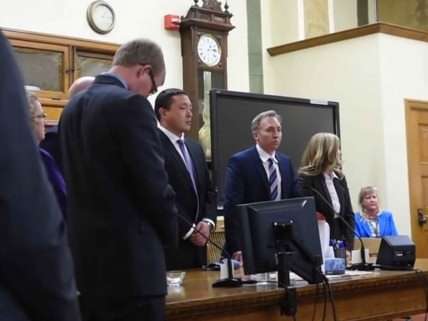Maybe Montana Didn't Legalize the Summary Execution of Unarmed Trespassers

Last May The New York Times ran a story that suggested Montana's law regarding the "use of force in defense of occupied structures" was responsible for the death of Diren Dede, a 17-year-old German exchange student who was killed while sneaking into a Missoula garage late one night last April. One of the homeowners, Markus Kaarma, fired four shotgun blasts into the dark, striking Dede twice. Kaarma, who lived in the house with his partner and their 10-month-old child, was on edge after being burglarized twice before. But there was evidence that he was itching for a confrontation and may even have laid a trap: He set up a surveillance camera in the garage, put a purse there, and left the garage door open. A hairstylist who knew him told police he had talked about sitting up with his shotgun for three nights running, waiting "to shoot some kid." The Times implied that the deadly shooting might nevertheless be justified under Montana law, thanks to changes made in 2009 that "allow residents more legal protections in using lethal force to defend their homes."
This week 12 Montanans disagreed, unanimously convicting Kaarma of deliberate homicide, which carries a minimum penalty of 10 years in prison. Under the instructions the jurors received, Kaarma's use of deadly force was justified only if he reasonably believed it was necessary to prevent an assault or other forcible felony. Given the circumstances, the jurors evidently concluded, such a belief was not reasonable. Although Dede entered the garage illegally, planning to steal something, he was unarmed and did not seem intent on violence. To fire at him in the dark without warning seems rash and excessive, which is one reason the case received so much publicity.
Another reason is that the shooting supposedly illustrated the recklessness of beefing up "castle doctrine" laws so that it is easier to justify the use of deadly force. Hence the headline over the story in the Times: "In Youth's Death, Some See a Montana Law Gone Wrong." In 2009, according to the Times, Montana legislators "placed the burden on prosecutors to rebut claims of self-defense." That is not true, since even before 2009 prosecutors had to prove beyond a reasonable doubt that a defendant's use of force was not legally justified, which is another way of saying they had to prove beyond a reasonable doubt that the defendant committed a crime. That approach prevails in courtrooms across the country, not just in Montana.
The relevant change made in 2009, which the Times also mentions, was the elimination of a requirement that a home intruder enter in a "violent, riotous or tumultuous manner." But that revision did not save Kaarma, because he still had to argue that he reasonably believed firing his shotgun into the garage was the only way to prevent Dede from attacking him or someone else in the house. To acquit him, the jurors did not have to completely believe his account, but they did have to find it plausible.
This seems to be another case, like Michael Dunn's 2012 murder of Jordan Davis in Jacksonville, Florida, where a state's excessively broad self-defense law was blamed for a shooting it did not in fact justify. In both cases, the outrageous acquittals that critics of the laws anticipated never actually happened. That does not mean both of these laws are perfect. But in one case after another, shootings that supposedly highlight the flaws of recently revised self-defense laws turn out to be justified under the old laws or unjustified under both. Although I try to keep an open mind, this pattern makes me skeptical of the case against laws that strengthen the castle doctrine or eliminate the duty to retreat outside the home.
The Times has no such reservations. The paper persistently misrepresented the role that Florida's "stand your ground law" played in the Dunn and George Zimmerman cases, and it uncritically repeats similar claims about other shootings, usually without bothering to explain exactly how the controversial changes are expected to affect the legal outcome.


Show Comments (78)